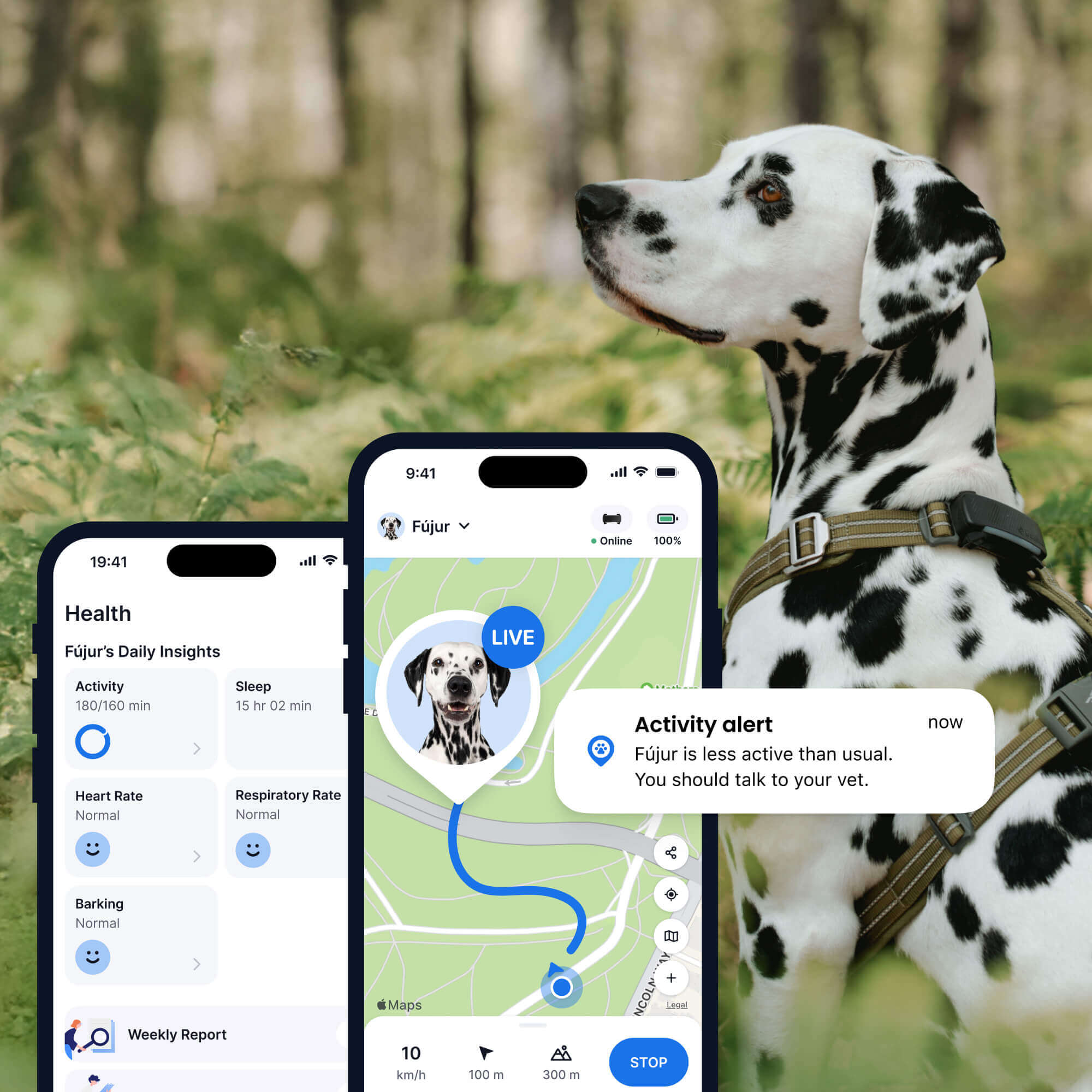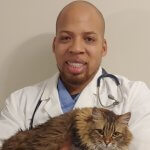 Approved by Dr. Dwight Alleyne, DVM
Approved by Dr. Dwight Alleyne, DVM Dog Drooling A Lot? What To Do (And When To Worry)
Dogs drool for a whole bunch of reasons - ranging from benign to more serious. So here's how you can get to the bottom of your buddy's slobbery troubles, once and for all.
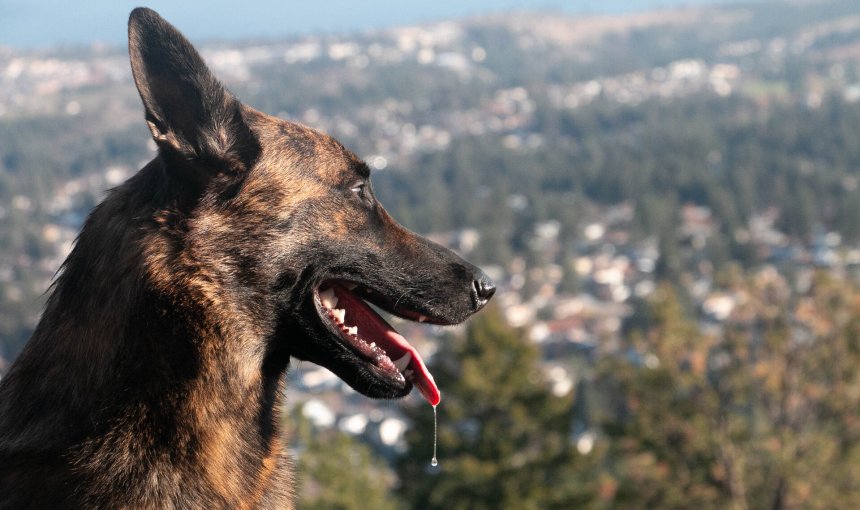
As adorable as our furry buddies are, there’s nothing quite like cuddling on a couch with them – only to find your arm or shoulder covered in slobber. But if you’re finding your dog drooling a lot – it might not be as benign a sign as you think. So if you’re constantly wiping up slobber or looking up dog bibs on Amazon, keep reading. In this post, we’re going to cover all the reasons behind why dogs drool, including when it’s normal, and when it could be a sign something’s wrong. (Plus, how a drop in your dog’s activity can signal they need a vet.) Let’s get started.
Key Takeaways
Some drooling is completely natural. But too much can indicate dental problems (like gum disease or tooth decay), oral injuries, foreign objects stuck in the mouth, or more serious medical conditions.
Head to your vet if the drooling is sudden, unusually heavy, or paired with symptoms like bad breath, vomiting, lethargy, pawing at the mouth, or behavior changes.
The Tractive GPS & Health Tracker includes vital signs and wellness monitoring, letting you track changes in rest, activity, or stress levels – helping you identify early signs of illness that may be linked to abnormal drooling. So you can act quicker and get your dog over for a checkup earlier.

Always know your buddy is healthy & safe
Read moreWhy do dogs drool?
As gross as it can be to deal with, drooling actually plays a natural role in your buddy’s life. It tends to help your buddy:
- Digest food easier. Saliva keeps your dog’s mouth lubricated, which helps for chewing and swallowing food – and eventually breaking it down in their stomachs.
- Keep cool when it’s hot, especially when they pant. You might find this more often among dog breeds that overheat easier, like Pugs and Bulldogs.
- Show they’re excited – like when they’re waiting for a meal! Their bodies are just prepping for digesting the food you’re about to serve them by producing some extra saliva.
Do some dog breeds drool more than others?
Yup, and it’s got to do with how their faces are built – especially around the jowls. Breeds with loose lips and loose skin around their mouths are just known for being droolers. Meaning “excessive” drooling might just come with the territory! Here are a couple of natural slobberers from the dog family:
- Saint Bernards,
- Mastiffs,
- Newfoundlands,
- Bloodhounds,
- Boxers,
- Great Danes,
- and Bulldogs
All of whom tend to have “looser” jowls, which makes it difficult for them to keep the saliva in their mouths.
Some dogs might also drool as a result of conditions they’re born with.1 Like, for example, a hiatal hernia – where their upper abdomen pushes in their chest. This is common among Brachycephalic dog breeds, like Pugs and Bulldogs. Or a portosystemic shunt, which is a condition affecting dogs’ blood vessels. This is common among Terries, Sheepdogs, Beagles, and Irish Wolfhounds.
Now while some amount of drool is 100% normal, a sudden increase in drooling can be a concerning sign. So let’s find out…
Why is my dog drooling so much? The more concerning reasons
Excessive drooling in dogs could be triggered by:
- The heat outdoors
If the drooling persists and your buddy doesn’t seem to be cooling down, it could be a case of heat exhaustion – if not worse. - Fear, stress & anxiety
Some dogs might drool out of fright if there’s a storm approaching or you’re taking them somewhere unfamiliar like the vet, or there’s a bigger, scarier animal nearby. - Motion sickness
Watch out for extra drooling around car rides, plus signs like whining, restlessness, and poor appetite. Keep some medication at hand before you head off on road trips and some cleaning items to take care of any emergencies. (Like if your dog needs to barf.) - A stuck foreign object
If something is lodged in your buddy’s gums, teeth, or throat, their mouths might trigger drooling to try and get rid of it. These could include sticks, rocks, bones, bits of toys, or even garbage. Watch out for signs like your dog pawing at their mouth or even refusing to eat. - Dental problems
Gum or tooth trouble can trigger drooling. Watch out for symptoms like bad breath, blood, pus, a reluctance around meal times, and any swelling around your buddy’s mouth. If you notice any of these, it might be time for a trip to the vet. - Something toxic
Poisoning can cause your dog to drool as a warning sign, like if they’ve licked at something covered in pesticide or even some food off-limits to dogs.
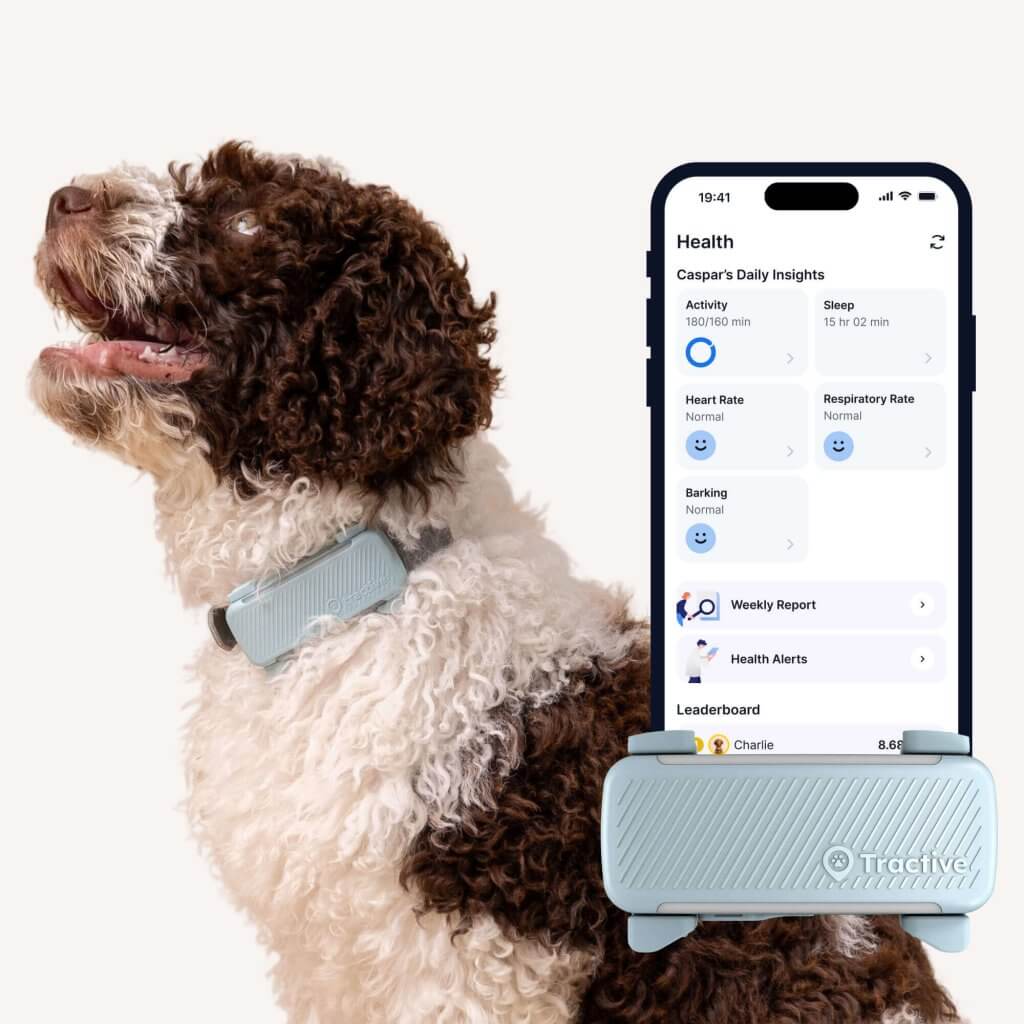
Get health alerts for your dog
Our pups can’t always tell us if something’s wrong. But if their tracker detects unusual changes in their routine, you’ll get an alert, helping you catch potential issues early.
Other medical conditions that might cause your dog to drool more
A couple of serious medical conditions might involve your dog drooling as one of their symptoms. Including:
- Liver disease,
- Gastrointestinal disease, including gastritis, ulcerations, or even inflammatory bowel disease
- Kidney disease,
- Viral or bacterial infections,
- Congestive heart failure,
- Some kinds of cancer,
- Chemical burns, like from chewing a wire or biting into a battery – which can also cause bleeding and lesions.
- And even some neurological conditions that can make it difficult for dogs to swallow their own saliva.
If your buddy’s drooling comes accompanied with other symptoms like fatigue, weight loss, and behavioral changes – like a drop in their daily activity – drop by your vet for a checkup.
Is excessive drooling in dogs an emergency?
Not always. But there do exist situations where you’re best off acting quickly. Besides any extra drooling, watch out for these red flags:
- Labored breathing,
- A swollen face or throat,
- Vomiting or diarrhea persisting past 24 hours,
- Tremors or seizures,
- Bleeding,
- Dizziness,
- Panting,
- Pawing at the mouth,
- Pale or blue gums,
- Lethargy or unresponsiveness
- Uneven pupils,
- Restlessness,
- Loss of appetite,
- Other changes in behavior, including aggression and whining
🚩These signs could signal a dangerous medical condition, like poisoning, a severe allergic reaction, heart disease, or even heatstroke. All of which need immediate medical attention.
What to expect at your vet if your dog is drooling a lot
Your vet will begin with a physical checkup, focusing around your dog’s mouth and neck to figure out what might be causing the drooling. Go prepared to answer questions like:
- Your dog’s medical history, including medications and vaccinations
- Your dog’s regular eating (and drooling) habits,
- Where your dog tends to spend most of their time (including where they might be exposed to any potentially toxic substances or foreign objects they might’ve eaten)
Your vet might conduct a couple of diagnostic tests to figure out the cause of your dog’s drooling, including blood tests and X-rays. In more serious cases, they might even recommend an ultrasound or a biopsy.
What your vet might prescribe as treatment
Based on what turns out to be the cause, your vet might prescribe:
- Specific medication, including antibiotics, if the cause of your dog’s drooling is an infection.
- Pain medication, including anti-inflammatory medication to help reduce any swelling
- Dental treatment, if the cause turns out to be tooth trouble. This might include regular cleanings or even tooth removal, in serious cases.
- And in some cases, even surgery, if the cause turns out to be a tumor or a condition your dog’s been born with.
Home remedies for dog drooling
Now while you can’t stop your buddy from slobbering all over you or the couch entirely, here are a couple of ways you can manage the situation by yourself at home. (Or as your dog’s recovering.)
- Keep your buddy cool & well-hydrated
Make sure your dog has plenty of cool, shaded spots to rest – and plenty of water to drink. Try using cooling mats, fans, or umbrellas in your backyard to help keep their body temperature down. Add some ice cubes to their water bowl to help cool them down. - Help your dog relax
If anxiety triggers drooling, lavender sprays and pheromone dispensers can help your buddy relax. Likewise, anxiety vests, weighted blankets, or thundershirts can help “swaddle” them and feel safe. Calming music or white noise can mask any “scary” sounds like fireworks. - Make dental care a priority
Use a pet-safe toothpaste to clean your dog’s teeth after meals. Dental chews or a dental wipe are alternatives in case your dog doesn’t like it. Else, add some dental powder to your dog’s water bowl to help them lap it up during mealtimes. - Be extra mindful what your dog eats
Never let your dog enter your kitchen unsupervised. Watch out for indoor “snack spots” like kitchen counters, tables, pantries, cabinets, under the dining table, or even trash bins. You want to avoid your dog eating any food that could potentially poison them instead.
Where a smart dog tracker steps in
More often than not, your dog drooling might be a sign that their bodies have already kicked into “fighting” mode. So if you’ve invested in a Tractive device, you’re in luck. With its built-in motion detector, your trusty Tractive GPS also includes Health Monitoring to stay on top of your dog’s overall wellbeing.
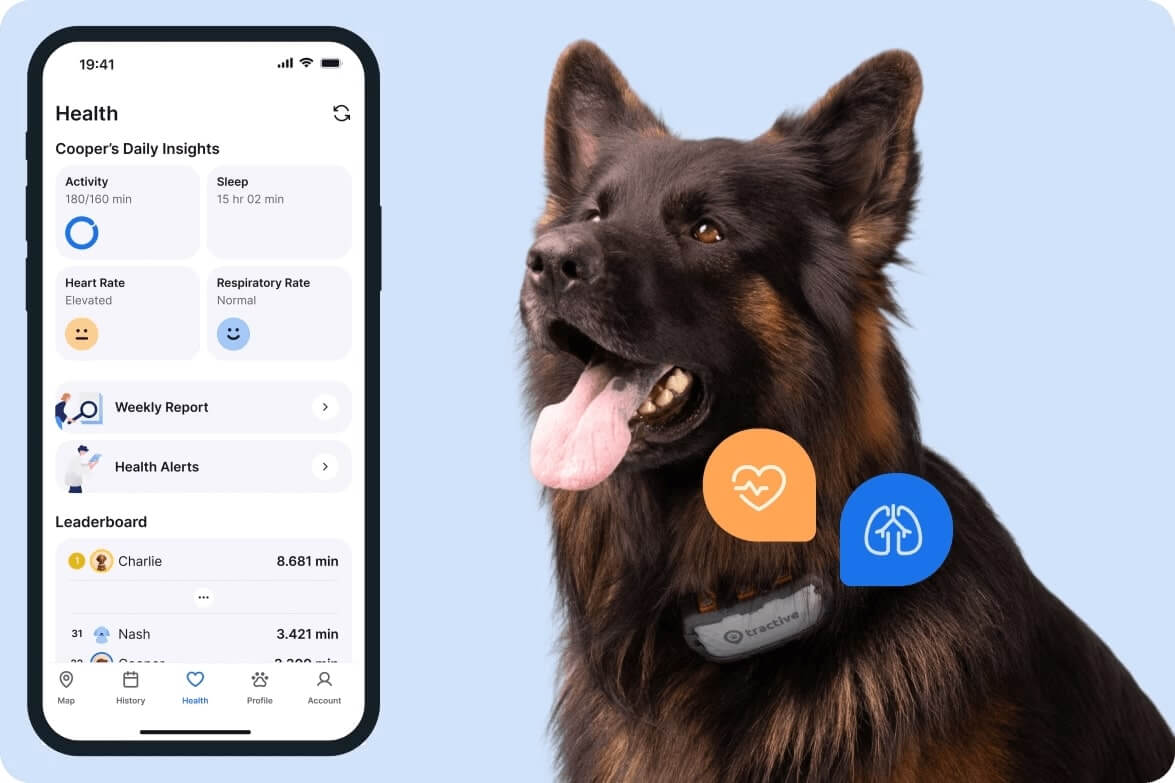
Including:
- Vital signs monitoring
An elevated heart rate or excessive panting could be signs of potential health issues – including cardiovascular problems. Once your dog’s worn their tracker for 7 days, you’ll now have a baseline to help you figure out what’s normal – and what’s not. - Real-time GPS tracking
To help you figure out where your dog might’ve come in contact with something poisonous, eaten something they shouldn’t have, or if they’ve been spending too much time in the sunny spots around your neighborhood. - Health Alerts
Your tracker also logs your dog’s daily activity and sleep quality – and sends you an alert in case something changes. (Which could signal sickness or pain.) So you can take action early and get them over for a checkup.
All this in one device – built with love for dogs and for your peace of mind as a dog parent.
Your furry friend’s health and wellbeing means as much as to us as it does to you. So we’ve made it a priority to only share medically-relevant content on our blog. This post was checked, double-checked, and medically verified by Georgia-based vet, Dr. Dwight Alleyne.

Dr. Dwight Alleyne, DVM
Originally from Long Island, New York, Dr. Alleyne began his career at a no-kill animal shelter before becoming a licensed veterinary technician. He graduated from Cornell University Veterinary College in 2006 and completed an internship at Purdue University. Now practicing in Georgia, Dr. Alleyne specializes in soft tissue surgery and ultrasounds. He also writes pet health articles on his website, “The Animal Doctor Blog” (www.anmldrblog.com).
